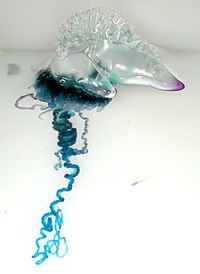
Photo from wikipedia
Protein A affinity chromatography is an important step in the purification of monoclonal antibodies (mAbs) and mAb-derived biotherapeutics. While the biopharma industry has extensive expertise in the operation of protein… Click to show full abstract
Protein A affinity chromatography is an important step in the purification of monoclonal antibodies (mAbs) and mAb-derived biotherapeutics. While the biopharma industry has extensive expertise in the operation of protein A chromatography, the mechanistic understanding of the adsorption/desorption processes is still limited, and scaling up and scaling down can be challenging because of complex mass transfer effects in bead-based resins. In convective media, such as fiber-based technologies, complex mass transfer effects such as film and pore diffusions do not occur which facilitates the study of the adsorption phenomena in more detail and simplifies the process scale-up. In the present study, the experimentation with small-scale fiber-based protein A affinity adsorber units using different flow rates forms the basis for modeling of mAb adsorption and elution behavior. The modeling approach combines aspects of both stoichiometric and colloidal adsorption models, and an empirical part for the pH. With this type of model, it was possible to describe the experimental chromatograms on a small scale very well. An in silico scale-up could be carried out solely with the help of system and device characterization without feedstock. The adsorption model could be transferred without adaption. Although only a limited number of runs were used for modeling, the predictions of up to 37 times larger units were accurate.
Journal Title: Biotechnology and bioengineering
Year Published: 2023
Link to full text (if available)
Share on Social Media: Sign Up to like & get
recommendations!